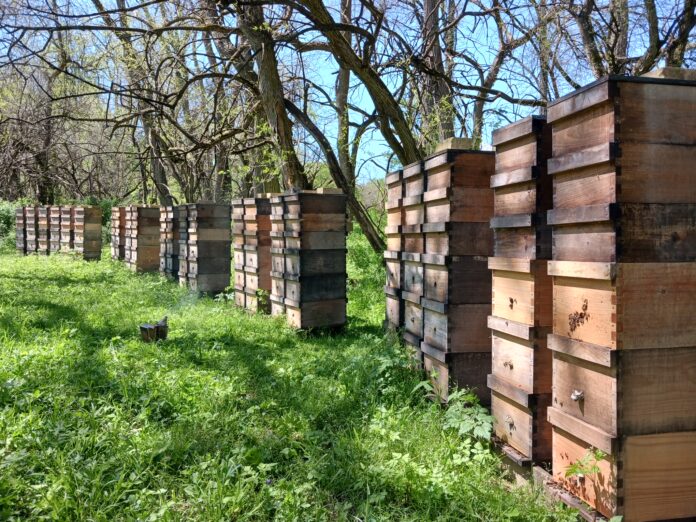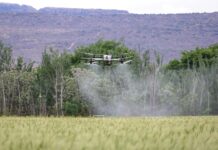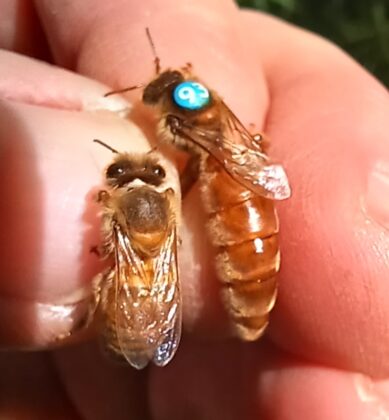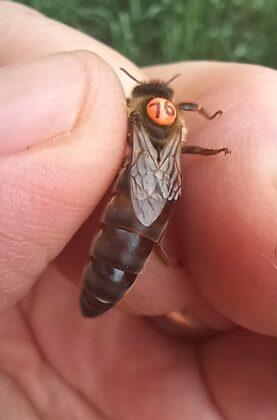
What does AI have to do with bees and beekeeping? Most dairymen or swine farmers are familiar with artificial insemination, a method of introducing sperm or semen into a female to introduce genetic qualities into their livestock. Years of selective breeding through AI can increase a dairyman’s herd’s milk production or produce leaner meat in both swine and beef production. These qualities can be achieved faster through AI management. How does this relate to beekeeping?
Producing superior queens
Joe Latshaw, owner of Latshaw Apiaries in Alexandria, Ohio, has one of the largest and oldest commercial queen breeding programs in the U.S. Latshaw’s queens can cost as much as $1,000 each, but don’t faint, dear reader, discounts are available for purchasing more than 10 queens. The questions are many, and the most commonly asked is how and why? The mechanics are different, but the result is the same. Collect the sperm and manually introduce it into the queen’s reproductive system.
Sperm are typically collected in the afternoon after the drones, which are the male bees, leave the hive. A queen excluder is placed in front of the hive that does not allow the drones to re-enter the hive when they return. The drones are larger-bodied than the worker bees and cannot fit through the wire enclosure. The drones are then netted as they congregate around the entrance, trying to get back in. The drones are one by one stripped of their semen by pushing against the posterior midsection, which will release the semen.
The semen is then collected and deposited into a queen. The queen is secured in a holding apparatus and viewed under a microscope, where she is then artificially inseminated with the proper amount of drone semen.
Latshaw explains queens can go on multiple mating flights in successive days to fulfill their need for mating and can mate with as many as 50 to 70 drones until the process is done. This sperm will be stored in her spermathecae and will last her entire lifetime. Once a queen is mated and starts laying eggs, she will not mate again. Research has shown that a physiological process happens that will not allow her to mate again. Some queens have been known to live up to seven years.
Latshaw’s breeder queens are offered in Italian, Carniolan and other hybrids. The queens are bred for either honey production, mite resistance, brood production or other favorable genetic traits and characteristics. They are purchased by large commercial beekeepers that will then produce hundreds, if not thousands, of their own queens from this superior stock.
Some breeders restock their own apiary and also sell the daughters of these queens. The daughter queens typically will sell for $25 to $35 each.
Latshaw believes improving genetics can lead to a 5% to 10% increase in honey production as well as other favorable traits such as less aggressiveness and more productivity.
Tips
When I asked Latshaw what tips he would recommend to both new and old beekeepers, he said, “Keeping varroa mites under control with different treatments is very important. These varroa mites multiply fast in the hive and can transmit many different viruses to bees.”
To be successful, the beekeeper must follow up on management practices in a timely fashion and be prepared to supplement feed when necessary. Latshaw can be reached through his website at latshawapiaries.com.
Spring challenges
As I write this on May 10 in northeast Ohio, we have had the past few weeks of cold, rainy conditions setting back farmers for tillage and planting. This cold, wet weather affects honey bees as the persistent rain washes out the nectar and pollen from the flowering trees and plants and reduces the bees’ flight time for foraging each day.
Bees will typically not forage on days with temperatures below 52 F, and high winds and rain will reduce or eliminate flight time. The bees will stay in the hive to cluster to keep their brood warm and consume more of their resources. Prolonged days of cold and wet rainy weather adversely affect bees in early spring.
There is no guaranteed outcome in any aspect of agriculture when it comes too Mother Nature. Whether you use your years of experience and intelligence or have a computer program with artificial intelligence, when it comes to all the variables in farming, no one has the answers every year. You follow your past successful practices, learn from your mistakes and others and do the best you can with the new challenges you encounter each year.
My Amish friend Eli says, just when you think you know it all, Mother Nature will serve you a great piece of humble pie to remind you who’s in charge.”















